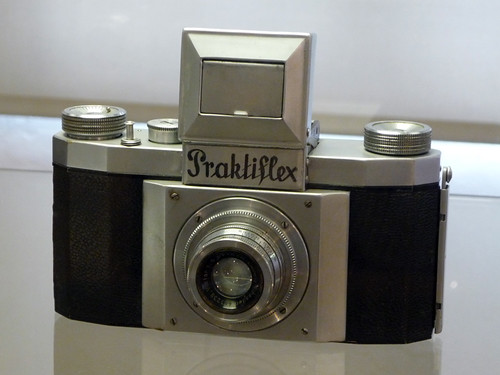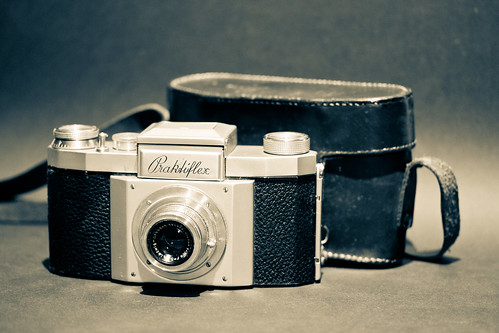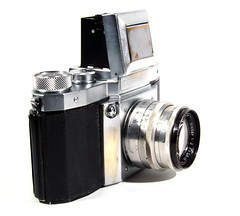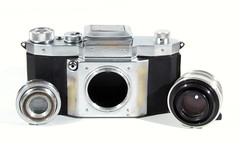Difference between revisions of "Praktiflex"
m (→First generation specifications) |
Hanskerensky (talk | contribs) m (→Links: Repaired Link URL) |
||
| Line 127: | Line 127: | ||
* [http://www.kyphoto.com/classics/instructionmanuals.html Manual available on the Favorite Classics section of kyphoto.com] | * [http://www.kyphoto.com/classics/instructionmanuals.html Manual available on the Favorite Classics section of kyphoto.com] | ||
In German: | In German: | ||
| − | * [http://www. | + | * [http://www.klassik-cameras.de/Praktiflex.html The development of the modern small format SLR camera], an article in [http://www.klassik-cameras.de/index.html Frank Mechelhoff's camera site], featuring the Praktiflex, Contax S, Exakta VX and original Pentax |
[[Category: German 35mm SLR]] | [[Category: German 35mm SLR]] | ||
Revision as of 11:44, 12 November 2015
The Praktiflex is a 35mm SLR film camera, manufactured by Kamera-Werkstätten VEB Niedersedlitz, (KW) Dresden, former East Germany and produced between 1939-49. KW was the third manufacturer to introduce a 24×36 SLR camera; only the Kine Exakta and the Russian Sport preceded it. Also, the Praktiflex was the world's first small-format SLR camera with a returnable mirror and with a screw mount for interchangeable lenses.
Its successor, the Praktica, became a very long and successful series of models.
The Praktiflex has a special 40mm in diameter screw thread lens mount, and takes only Praktiflex lenses. The 42mm thread mount became available from about 1947, and was thus initiated by this manufacturer. This lens mount became practically an universal industry standard, until about 1975 when the need for increased exchange of information between camera and lens made the bayonet mount a more practical arrangement.
There are many models and variants of the Praktiflex. They could be divided two main generations. [1] The first generation includes pre-WW2 models and the second generation includes post-WW2 models.
Contents
First generation specifications
- Produced between 1939-46
- Lens: offered with various brand's lenses [2]
- Mount: M40x1 screw type
- Focusing: via condenser type ground-glass focusing screen
- Shutter: horizontal-run rubberised cloth-blind type shutter speeds: 1/20-1/500, +B
- Shutter release knob: on the top of the camera
- Mirror: not instant return, raises by pressing the release button. Shutter releases only when the mirror is raised.
- Viewfinder: Waist-level view finder with condenser type ground-glass focusing screen (Stevens Screen), fixed, w/ Magnifier and eye level sports finder
- There are some variants with special coloured leatherette like red, blue, gray.
- Some variants have no strap lugs and some variants have strap knobs
|
| ||||
Second generation specifications
- Produced between 1947-49
- Lens: Praktiflex offered with various brand's lenses [2]
- Lens mount: M40x1 screw type
- Focusing: via condenser type ground-glass focusing screen, w/ central cross
- Shutter: horizontal-run rubberised cloth-blind type shutter speeds: 1/25-1/500, +B
- Shutter release knob: on front of the camera
- Cocking knob: also winds the film, auto-stops on film-advance
- Mirror: not instant return, spring raised mirror returns when the shutter cocked
- Viewfinder: Waist-level view finder with condenser type ground-glass focusing screen (Stevens Screen), fixed, w/ Magnifier and eye level sports finder
- Back cover: Removable
- Others: Tripod socket: 3/8 inch; Strap lugs
- Body: metallic; Weight: 748g
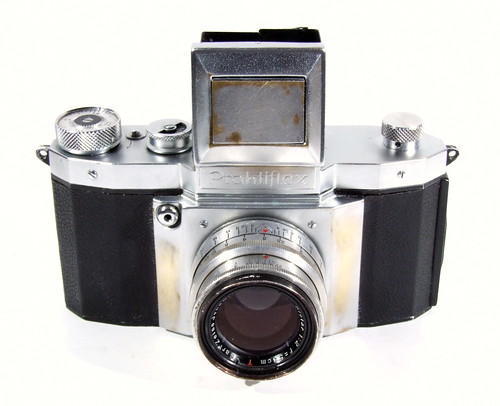
|
| Praktiflex 2nd generation, 15th model, (Hummel 079, Schulz version 15), 1947, w/ Carl Zeiss Jena Biotar T, 58mm f/ 2 [4] image by Süleyman Demir (Image rights) |
|
|
| ||||||
| Praktiflex 2nd generation, 15th model, (Hummel 079, Schulz version 15), 1947, w/ Carl Zeiss Jena Biotar T, 58mm f/ 2 Images by Süleyman Demir (Image rights) | ||||||||
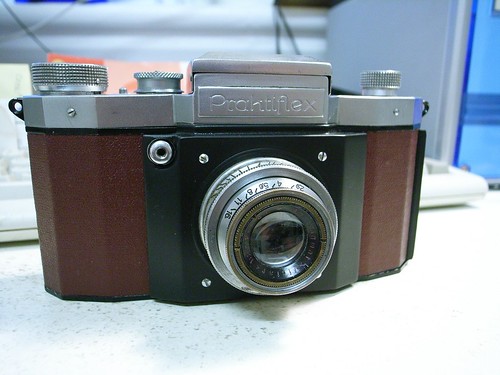
|
| Praktiflex 2nd generation-15th model, brown leatherette, (Hummel 079, Schulz version 15), (1947-49), w/ E.Ludwig Anastigmat-Victar 50mm f/2.9 (The front plate was originaly chrome, not black painted) [5] image by botakjay (Image rights) |
Praktiflex FX
The name Praktiflex FX was briefly used in the 1950s for a USA export name for a version of the Praktica FX. It was also sold under various other brand names such as "Columbia 35" and "Rival Reflex" in export markets.
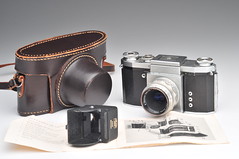
|
| Praktiflex FX image by Peter M Lerman (Image rights) |
Notes and references
- ↑ Generation, model and version IDs are as to Mike's Praktica Collection
- ↑ 2.0 2.1 Praktiflex lenses
- ↑ as to Mike's Practica Collection
- ↑ as to Mike's Practica Collection
- ↑ as to Mike's Practica Collection
Links
- in EarlyPhotography
- in Mike's Praktica Collection
- Praktiflex FX at Praktica collector's [1]
- Manual available on the Favorite Classics section of kyphoto.com
In German:
- The development of the modern small format SLR camera, an article in Frank Mechelhoff's camera site, featuring the Praktiflex, Contax S, Exakta VX and original Pentax
